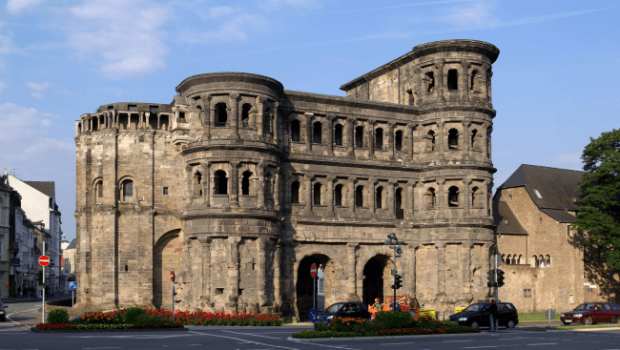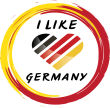
Trier is also otherwise known as Treves. It is a city located on the banks of the river Moselle in Germany. The city is surrounded by hills of red sandstone and is situated towards the west of Rhineland-Palatinate. It is also quite close to the border of Luxembourg and within Moselle valley region. The slopes of this valley are green, laden with trees and vineyards and it extends up to Hunsruck plateau and Eifel on the southern and northern sides respectively. Trier is considered to be the oldest city of the German state and also the oldest seat of the Bishop on the northern side of the Alps. Furthermore, after Mainz, Ludwigshafen and Koblenz, Trier becomes the fourth largest city in the state. The urban landscape of Trier is divided into 19 districts. One of the most crucial figures form history, Karl Marx was born in this city in the year 1818.
Climate
Trier is located in a temperate climate type zone. The region experiences a reasonable amount of rainfall and annually the average temperature reaches 9.3 degree Celsius. The warmest months fall between June and August with the temperature rarely going over 20 degrees Celsius. On the other hand the colder months start from December and end with February. The average temperature around this time of the year ranges from 0.6 to 1.6 degree Celsius.
History
There still remains a slight amount of ambiguity related to the origins of the regions. But, the Celts were the one who are said to have placed the founding stones of the region during the latter half of the 4th century BC. Moreover, they had named the region as Treuorum. The Romans came in the region during 1st century BC and renamed it as Trevorum or Augusta Treverorum which when translated from Latin to English becomes The City of Augustus. It was thus named in the honor of the first emperor Augustus.
The province of Belgic Gaul took over the city as its capital and later on with the enactment of the Diocletian Reforms the city would become the capital of the prefecture of the Gauls. The city also acted as an overseer of the Western Roman Empire. At around this time, Trier would still be classified as one of the largest cities of the province with a massive residential population. The current day Porta Nigra or the Black Gate is a monument which dates back to this time period. The city in-fact never lost its strategic momentum in the history. There still were factories which produced armors, ballistae, woolen uniforms and other garments of different qualities.
The Roman control of the city went on for a very long time and the region also prospered and imbibed itself in their traditions. It was much later at around A.D. 459 when the Franks would take control of Trier and after nearly half a millennia, Trier, in AD 870 became a part of Eastern Francie. This region would further become the Holy Roman Empire in the coming years.
Later-on, when the relics of Saint Mattthias were brought to Trier, the city grew in prominence and developed as a site for widespread pilgrimage. Therefore, in the due course as the number of pilgrims increased, so did the powers of the bishops. The influence of the Archbishops of Trier grew immensely to the point where it became the electorate of the empire and thus a powerful state in Germany. During the Middle Ages the Holy Roman Empire had an important representative in Trier, who was the Archbishop-Elector.
During the more conflict oriented time of the 17th and 18th centuries, Trier was desired by French rulers. There were many invasion strategies which came about during the Thirty Years War, the War of the Grand Alliance, the War of the Spanish Succession and then the war of the Polish Succession. Moreover, it was only as the French Revolutionary Wars were in progression, particularly in 1794 when the French intentions reached a culmination with the succession of Trier. As soon as the occupation happened, right then the electoral archbishop was dissolved. With the end of the Napoleonic Wars in 1815, Trier moved into the Kingdom of Prussia. Under the Prussian rule, Trier underwent a massive economic overhaul. The city also rose to revolt during the 1848 revolution. Moreover, nothing substantial was able to manifest as the rebel forces easily conceded and in 1871 Trier became a part of the German Empire.
As we move to the new century, Trier came to be known for a rather in humane walk which was conducted by the Nazi administration. What had happened was that nearly 60,000 British soldiers were captured at Dunkirk and the northern region of France and then made to march towards Trier. Furthermore, during the War in 1944, the city was heavily bombarded and the post war period saw it becoming a part of Rhineland-Palatinate.
As per a 12th century legend recorded in the Deeds of the Treveri, the foundations of the city are said to have been laid by an eponymous – Trebeta, the unrecorded prince of Assyria. This legend came about after a discovery was made in the markets of Trier, which was the façade of the Red House. The façade carried certain inscriptions which spoke of the legendary king of Assyria, Ninus whose son was Trebeta. The origin story further unfolds that the mother of Trebeta was unknown and was the wife of Ninus’s before he married Semiramis.
Things to know while travelling in Trier
The closest city to Trier at a distance of 50 kilometers or 31 miles is Luxembourg. A little ahead on the southeastern side, at a distance of 80 kilometers or 50 miles is Saarbrücken, and further, at a distance of 100 kilometers or 62 miles in the northeastern direction is Koblenz.
Important sites to visit
- Porta Nigra: It is in-fact the best preserved Roman city gate on the northern side of Alps.
- Roman Baths: These three baths are throughout in a ruinous state.
- Constantine Basilica: This massive basilica was designed keeping in mind the true Roman sensibilities. It used to be the where Roman Emperor Constantine presided in his 67 meter long throne hall. Today, it is being used as a Protestant Church.
- Trier Cathedral: Also otherwise known as Trier Dom or Dom St. Peter, the cathedral performs the function of a Roman Catholic Church. The most prized exhibit of the Church is the Holy Tunic. It is considered to be the robe of Jesus Christ himself, which he was wearing when he died and is placed on display at irregular intervals every few decades.
- Liebfrauenkirche: Designed under the French Gothic tradition. The Church of Our dear Lady is among the most important churches in the whole of Germany.
- Trier Amphitheater: This Roman amphitheater is another popular site and must be explored.
- Römerbrücke: It is the oldest Roman Bridge which belongs to the 2nd century AD and is situated over the river Moselle. What is interesting is that people still use this bridge for regular commute.
- Matthias’ Abbey: It is the Abbey of St, Mathias belonging to the medieval tradition. The monastery is quite important and it is the only one north of Alps where the dead are buried.
- Gangolf’s church: It is the city’s market church.
- Saint Paulinus’ Church: It is a church belonging to the Baroque tradition which was designed by Balthasar Neumann.
- Rheinisches Landesmuseum: Is among the most important archaeological museums in Germany. Here you can find artifacts belonging to the Roman period.
- Stadtmuseum Simeonstift: This museum houses many exhibits from the medieval city and the entire history of Trier is also on display here.
- Toy Museum of Trier: Another interesting and must visit site.
- Karl Marx House: The house has been converted into a museum which houses items from personal life of Karl Marx, volumes of poetry, original letters, and photographs among other things.
- Fell Exhibition Slate Mine: It is probably the most exciting of all the museums because it contains an underground mine.
In addition to these prominent sites there are many other monuments and buildings of interest and allies of mystery which require exploration. Another important site of exploration could very well be the University of Trier which was established here in 1473 and then shut down in 1796. The university restarted itself only in 1970.
Trier is also on the map because of the World Rally Championship which has been going on since the year 2000. It attracts quite a lot of motorsports enthusiasts from all over the world. Also, if you happen to be there around Christmas then you will indeed be amazed by the nature of street Christmas parties.
Travelling in and around Trier
The main station at Trier is well connected with all the major cities in and around Germany. The closest cities that can be reached through trains are: Cologne, Saarbrücken and Luxembourg. The major roadways are A 1, A 48 and A 64. These networks connect with the major cities. Furthermore, the closest international airport at a distance of about 40 minutes’ worth of a drive can be found at Luxembourg. Frankfurt and Cologne/Bonn, both are a bit far and the travel reaches nearly 2 hours.
Finally, if you are the adventurer kind then the Moselle River waterway can be a very good option to travel. There are river cruises and boat rides also available among other things.
